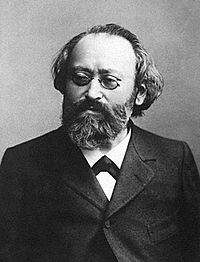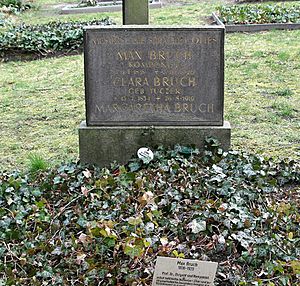Max Bruch facts for kids
Quick facts for kids
Max Bruch
|
|
|---|---|
 |
|
| Born |
Max Bruch
6 January 1838 |
| Died | 2 October 1920 (aged 82) Berlin-Friedenau, Germany
|
| Era | Late Romantic |
|
Notable work
|
See: List of compositions by Max Bruch |
| Spouse(s) | Clara Tuczek |
| Parent(s) | August and Wilhelmine Bruch |
| Signature | |
Max Bruch (born January 6, 1838 – died October 2, 1920) was a German Romantic composer. He was also a violinist, teacher, and conductor. He wrote over 200 musical pieces. His most famous work is his first violin concerto, which is still very popular today.
Contents
Early Life and Learning
Max Bruch was born in 1838 in Cologne, Germany. His mother, Wilhelmine, was a singer, and his father, August, was a lawyer. Max had a sister named Mathilde.
He started learning music at a young age from Ferdinand Hiller, a famous composer and pianist. Another talented musician, Ignaz Moscheles, also noticed how gifted Max was.
When Max was just nine years old, he wrote his first song for his mother's birthday. From that moment on, music became his biggest passion. His parents strongly supported his musical studies. He wrote many early pieces, including songs, piano music, and even orchestral works. Most of these early works are now lost.
In 1849, he had his first music theory lesson in Bonn. He was staying at a farm in Bergisch Gladbach at the time, where he composed a lot of his music. Later, a woman named Maria Zanders became a good friend and supporter of Bruch.
His Career
After studying philosophy and art briefly in Bonn in 1859, Bruch began a long career. He worked as a teacher, conductor, and composer in many German cities. These included Mannheim (1862–1864), Koblenz (1865–1867), and Berlin (1870–1872).
At the peak of his career, he spent three years as the conductor of the Liverpool Philharmonic Society in England (1880–1883).
From 1890 until he retired in 1910, he taught composition at the Berlin Hochschule für Musik. One of his notable students was the German pianist and composer Clara Mathilda Faisst.
Family Life and Later Years
Max Bruch married Clara Tuczek, a singer, on January 3, 1881. They had met while he was on tour in Berlin. Clara came from a musical family, and her sister, Felicia Tuczek, was also a composer.
The couple moved back to Liverpool, England. Their daughter, Margaretha, was born there in 1882. Their first son, Max Felix, was born in 1884 and showed great musical talent. They later had two more sons, Hans and Ewald.
Death
Max Bruch passed away at his home in Berlin-Friedenau in 1920. He was buried next to his wife, Clara, who had died the year before. They are buried at the Old St. Matthäus churchyard in Berlin-Schöneberg. His daughter, Margaretha, later had the words "Music is the language of God" carved on his gravestone.
His Music
Max Bruch's music followed the German Romantic style. He was known for his well-structured and complex pieces. He was often seen as a "Romantic classicist," similar to Johannes Brahms. He was different from composers like Franz Liszt and Richard Wagner, who were part of the "New Music" movement.
During his lifetime, Bruch was mainly known for his choral music. However, he was often overshadowed by his friend Brahms, who was more popular.
Today, just like when he was alive, Bruch's Violin Concerto No. 1, in G minor, Op. 26 (written in 1866), is one of the most loved Romantic violin concertos. It uses some ideas from Felix Mendelssohn's Violin Concerto, like connecting the movements.
Two other works by Bruch are still widely played today. These are also for a solo string instrument with an orchestra:
- The Scottish Fantasy for violin and orchestra. This piece includes a famous Scottish tune called "Hey Tuttie Tatie."
- The Kol Nidrei, Op. 47, for cello and orchestra. This piece is based on a Kol Nidre prayer, which is sung at the start of the Jewish Yom Kippur service.
Because of Kol Nidrei, many people thought Bruch was of Jewish background. However, Bruch denied this, and there is no proof that he was Jewish. He was raised Protestant. During the time of the Nazi Party in Germany (1933–1945), his music was restricted. This was because he was thought to be a "possible Jew" for writing music with a Jewish theme. As a result, his music was largely forgotten in German-speaking countries for a while.
Bruch also wrote many pieces for chamber music (music for small groups of instruments). His "Eight Pieces for Clarinet, Viola, and Piano" are sometimes performed. He wrote these pieces for his own son, Max, who was a clarinettist. He also wrote two string quartets early in his career.
Towards the end of his life, in 1918, Bruch wrote two string quintets. One of these became the basis for a string octet, written in 1920. This octet was for four violins, two violas, a cello, and a double bass. At this time, composers like Schönberg and Stravinsky were creating new, modern styles of music. But Bruch continued to compose in the traditional Romantic style.
Bruch's other works include two less famous violin concertos: No. 2 in D minor (1878) and No. 3 in D minor (1891). He thought these were just as good as his famous first concerto. He also wrote a Concerto for Clarinet, Viola, and Orchestra. His three symphonies also show his unique German Romantic style.
Later in life, he added three orchestral suites. The third suite has an interesting story. Bruch got the idea for it in Capri, Italy, after hearing a tune played on a tuba during a procession. He thought it would make a good funeral march. He finished this suite in 1909.
The American piano duo, the Sutro sisters, asked Bruch to write a concerto just for them. He arranged his third suite into a double piano concerto. This piece, the Concerto in A flat minor for Two Pianos and Orchestra, Op. 88a, was finished in 1912. The sisters performed it only twice, in their own changed versions. The original score was lost for many years and only found after Ottilie Sutro's death in 1970.
Famous violinists like Joseph Joachim and Willy Hess gave Bruch advice on writing for the violin. Hess even performed some of Bruch's new works for the first time.
Images for kids
-
Memorial for Bruch and Maria Zanders in Bergisch Gladbach
See also
In Spanish: Max Bruch para niños





